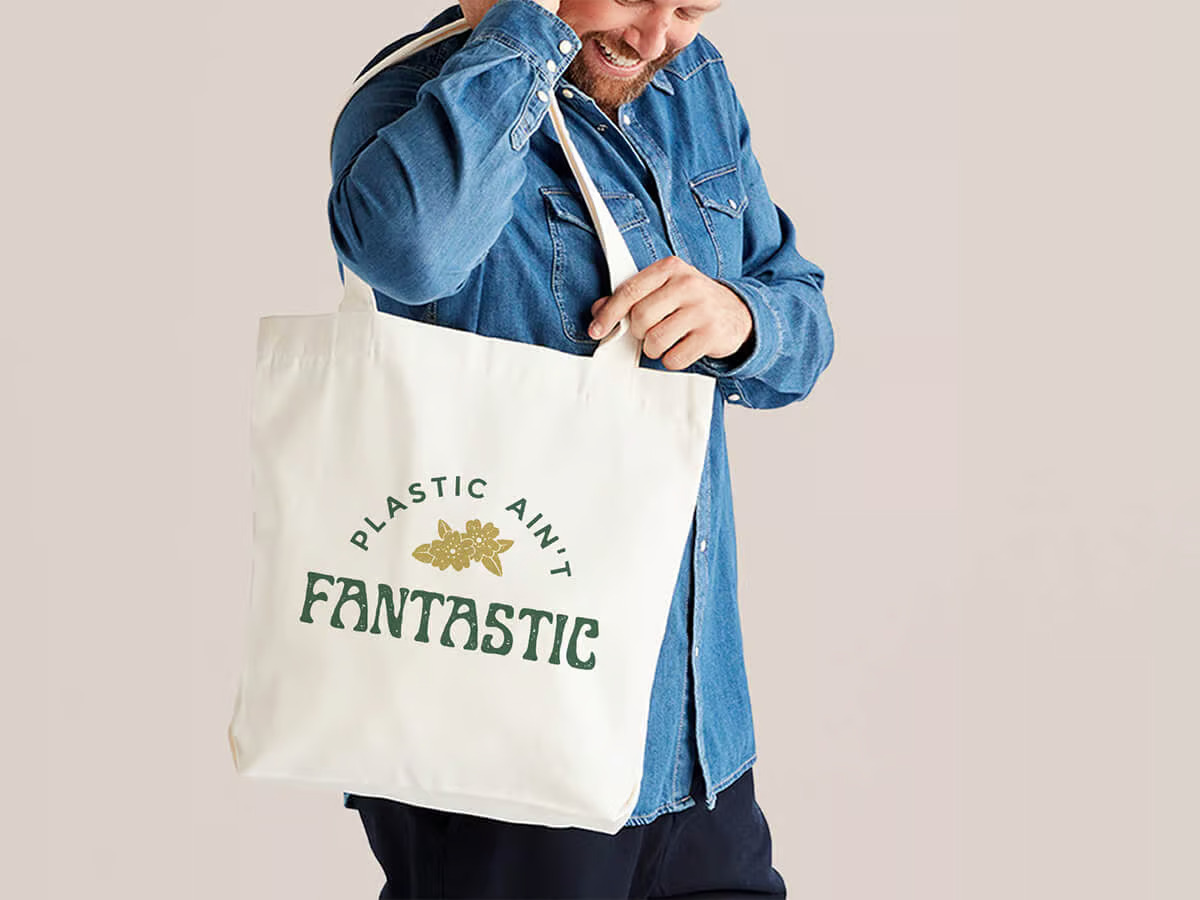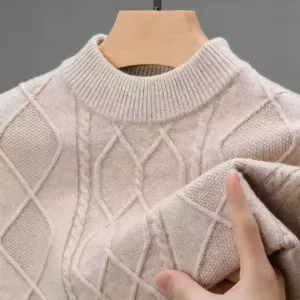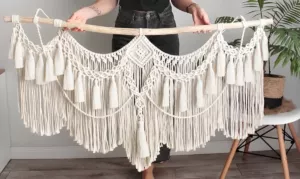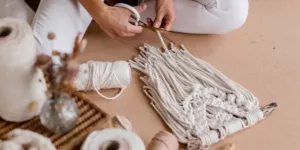Tote bags have become a popular staple in modern life, used for everything from groceries to books to beach trips. Though simple in design, the versatility and convenience of tote bags have made them a favorite for both personal and promotional use.
The origins of the tote bag can be traced back to the early 1900s, when cotton mesh bags were used to carry fruits, vegetables, and other goods from markets. These bags were durable, affordable, and reusable. In the 1940s, LL Bean created and popularized the Boat Bag, which had leather handles and a zipper closure. This established the tote bag as a functional accessory.
Today, tote bags come in all shapes, sizes, materials and designs. Custom printed tote bags have become an extremely popular promotional item. Whether given away at conferences, fundraising events or trade shows, custom printed totes offer an easy way to display a brand, logo or cause. Tote bags provide a useful, environmentally friendly alternative to plastic bags. With custom printing, the design options are endless.
Benefits of Custom Printed Tote Bags
Promotional printed tote bags offer a variety of benefits that make them an ideal choice for businesses, organizations, and events. Here are some of the top reasons to consider custom printed tote bags:
Inexpensive Promotional Item
Compared to many other promotional products, custom printed tote bags are very affordable. They can be produced in bulk at low costs, making them a budget-friendly option even for small businesses or non-profits with limited marketing budgets. The low cost allows organizations to distribute tote bags more widely at events, conferences, etc.
Reusable and Eco-Friendly
Tote bags are designed for reuse, unlike one-time use plastic bags. When people reuse tote bags, it reduces waste and plastic consumption. Printed cotton or canvas tote bags are especially sustainable options. The eco-friendly aspect makes custom tote bags popular giveaways for green organizations and environmentally conscious companies.
Portable and Convenient
The portable, lightweight design of tote bags makes them a convenient item that people will carry frequently. They easily fold up when not in use. The roomy interior provides ample space to hold various items, with some tote bags featuring inner pockets for organization. People tend to take reusable tote bags shopping, to the beach, farmer’s markets, and more.
Visible Branding Opportunity
With a large printable surface area, tote bags offer excellent branding real estate to showcase a logo, slogan, or message. The tote bag’s high portability means more opportunities for public exposure. People carry tote bags to many locations, providing passive advertising as others see the bag’s design. It’s an inexpensive way to get your brand in front of more eyes.
Popular Uses for Printed Tote Bags
Custom printed tote bags are extremely versatile and can be used by many different organizations and businesses. Here are some of the most popular uses for custom printed tote bags:
Conferences and Trade Shows
Tote bags are one of the most popular items to give away at conferences, conventions, and trade shows. Rather than giving attendees a pile of brochures and flyers, a printed tote bag allows them to easily carry all the items they collect at the event. Tote bags also provide a large printable surface area for the event name, logo, and any information you want to highlight. Attendees will use the bags during the event and continue to use them afterward, providing ongoing brand exposure.
Schools and Universities
Educational institutions from elementary schools to universities often use custom printed tote bags. Students can use the bags to carry books, laptops, and school supplies. Bags may be given out at orientation events, sporting games, or other school functions. Printed tote bags are a useful gift that students will use frequently.
Retail Businesses
Retail stores use custom printed tote bags as shopping bags for customers. Rather than giving out plain plastic or paper bags, printed tote bags become a walking billboard for the store’s brand. Customers will reuse these bags for their shopping trips. Retailers can include promotions, coupons, or contest announcements on the bags.
Nonprofit Organizations
Many nonprofit groups rely on printed tote bags for fundraising and awareness campaigns. Tote bags can be sold as a fundraiser, given to volunteers and donors, or provided at charity events. Nonprofits can print their mission statements, event details, sponsor logos, and calls to action on the bags. Supporters will carry these bags and help spread the organization’s message.
Tote Bag Materials
Tote bags can be made from a variety of materials, each with their own unique properties. Some of the most popular materials for tote bags include:
Canvas
Canvas is a durable, woven fabric that holds up well over time. It is thick and sturdy, yet remains lightweight. Canvas tote bags have a classic look and tend to be more affordable than other materials. Cotton canvas is the most common type used for tote bags.
Cotton
Cotton is a soft, breathable natural fiber that is comfortable to carry. Cotton tote bags have a casual, approachable aesthetic. Cotton can be prone to wrinkling and staining though, so it may require more care than synthetic fabrics.
Polypropylene
Polypropylene is a synthetic plastic-based material that is extremely durable and weather resistant. Polypropylene tote bags are reusable, washable, and recyclable. They resist moisture, stains, and mildew. However, polypropylene tends to have a more industrial, plastic-like texture.
Jute
Jute is a natural fiber made from plant materials that has an earthy, rustic appeal. Jute tote bags have an artisanal look and attractive natural color variations. However, jute fibers are coarse and can be scratchy. Jute also wrinkles easily. It is more susceptible to stains than synthetic materials.
Tote Bag Styles
Tote bags come in a variety of styles to suit different needs. Some popular styles include:
Basic Open Top
The basic open top tote is a simple bag with no closure at the top. This style allows for easy access to the contents. Open top totes work well for lightweight items that won’t spill out easily.
Zipper Top
For added security, many tote bags feature a zipper closure at the top. This contains items while still allowing convenient access. Zipper top totes are great for carrying small valuables or items like cosmetics that you don’t want spilling.
With Pockets
Some tote bags incorporate pockets, either on the exterior or interior of the bag. Exterior pockets provide quick access to items you need to grab easily. Interior pockets help organize contents and can secure smaller items.
Foldable
Foldable tote bags flatten or fold up into a compact size. This makes them easy to tuck away in a larger bag when not in use. Foldable totes come in handy for grocery shopping, travel, or carrying souvenirs or purchases.
Insulated
Insulated tote bags have an insulated lining that helps regulate temperature. This style keeps food or drinks cooler longer. Insulated totes are useful for picnics, trips to the beach, transporting cold food items, and similar situations. The insulation also helps prevent condensation from cold contents.
Tote Bag Printing Methods
There are several printing methods commonly used for custom printed tote bags:
Screen Printing
Screen printing is one of the most popular and cost-effective printing methods for tote bags. It involves using a mesh screen stencil to apply ink directly onto the bag surface. Screen printing works well for bold graphics, solid colors, and simple designs. It allows for printing on a wide variety of materials. However, it may not achieve the same level of photographic image quality as other methods. Screen printing is a great choice for high volume orders and affordable pricing.
Dye Sublimation
Dye sublimation printing offers full-color, continuous tone printing that makes it well-suited for photographic images. The process infuses dyes directly into the fabric, rather than applying ink on top. This allows for soft, permanent prints that won’t crack or peel. Dye sub is ideal for polyester fabrics. An advantage is the ability to wrap images around curves and edges. The main downside is higher setup costs, so dye sub works better for lower quantities.
Digital Printing
Digital printing refers to direct to garment or DTG printing. It allows for full-color printing without the setup costs of screen printing. Digital printing uses specialty printers to print directly onto the bag surface with water-based inks. The image quality can be very good for detailed photographic designs. Digital printing excels at small quantity, full-color orders. It does have some limitations on materials that can be printed.
Embroidery
Embroidery is used to sew logo or design elements directly into the bag fabric. It creates a raised, textured effect for a high-end finish. Embroidery is ideal for company logos, monograms, and other solid design elements. It provides a 3D element not possible with other printing techniques. The stitch count limits fine details and gradient colors. Embroidery works well combined with other printing methods.
Design Tips
When designing custom printed tote bags, there are some key tips to keep in mind:
Keep the Design Simple
Avoid overly complicated or busy designs. Tote bags offer a large canvas, but it’s best to stick to simple, clean designs that are easy to see. Too many small details may get lost at normal viewing distances. Focus on a few impactful elements like your logo, mascot, or slogan.
Use Large, Bold Text
Make sure any text used is large enough to read from a distance. Bold fonts work best. Consider your font colors as well—dark text on a light bag, or vice versa, provides the most contrast.
Include Your Branding
Feature your company name, logo, website, and other branding elements prominently. The goal is to turn your custom totes into walking advertisements. Place branding on both sides of the bag.
Use Relevant Imagery
Incorporate appropriate photos or illustrations that relate to your brand and reinforce your messaging. For example, a zoo could feature cute animals on their totes. A sports team could show their mascot and logo.
Preparing Artwork
When getting custom printing done on tote bags, it’s important that your artwork file is properly prepared and optimized to ensure the best print quality. Here are some key tips for preparing artwork files:
Required File Formats
The most common file formats accepted for tote bag printing are vector files like AI, EPS, and PDF. These formats allow for scaling to any size without loss of image quality.
For photographic images, high resolution JPG, TIFF, or PSD (at least 300dpi) are recommended. Lower resolution files may appear pixelated or blurry when printed.
Color Matching
For accurate color matching, supply Pantone coated swatches or CMYK colors. RGB colors can shift when printed so should be avoided if specific colors are needed.
If possible, include a low-res JPG mockup for reference of desired colors. The printer may still need to make adjustments for the printing process.
Bleed Requirements
Include 0.25in bleed around all edges of the design. This extra image area gets trimmed off but ensures no white edges.
Keep text/logos 0.5in from edges to avoid trimming. For full bleed backgrounds, extend artwork across entire document.
Following these tips will produce the best print quality for custom tote bags. Consult with your printer about specific requirements before finalizing artwork. Proper file setup is key for stunning printed bags.
Ordering Considerations
When ordering custom printed tote bags, there are some key factors to consider:
Quantity Discounts – Most tote bag suppliers offer quantity discounts, so ordering in larger volumes can help reduce the per-unit cost. Discounts often start at 100+ bags. Be sure to get quotes for different quantities to find the ideal order size for your budget.
Lead Time – Expect 2-4 weeks for production of custom printed tote bags. Rush service may be available for an upcharge. Order well in advance of when you need the bags, especially for large orders, to ensure timely delivery.
Add-Ons – Consider add-ons like interior padding for extra comfort and structure. Padding helps protect items inside the bag. You can also add features like pockets or adjustable straps. Discuss options with your tote bag supplier.
Art Preparation – Supply print-ready artwork files to avoid delays or additional charges. Your supplier can provide specifications for sizing, color formats, bleeds, etc.
Shipping Costs – Confirm how shipping is handled and if costs are included in the pricing quote. Ground shipping is standard, but expedited shipping can get the bags faster.
Payment Terms – Most companies require 50% down payment to start the order, with balance due before shipment. Inquire about payment options and timing.
Thinking through these key factors will help ensure a smooth ordering process and successful promotion with custom printed tote bags.
Conclusion
Tote bags are an extremely popular promotional item and branding opportunity. Custom printed tote bags allow businesses, organizations, and events to get their name and logo out there in a useful, eco-friendly way.
Key points covered in this guide on tote bag printing designs:
- Tote bags make great promotional giveaways at conferences, trade shows, and other events. They provide high visibility for brands and logos.
- Businesses like grocery stores, boutiques, and salons often offer custom printed tote bags to customers as a branding strategy.
- Schools, nonprofits, and community groups commonly sell printed tote bags as a fundraiser.
- Popular materials for tote bags include cotton, canvas, polypropylene, and recycled materials. Each has pros and cons.
- Tote bags come in different styles like open top, zipper closure, fold-over closure, and drawstring backpack.
- Printing methods include screen printing, dye sublimation, heat transfer vinyl, and digital printing. Screen printing works best on cotton bags.
- Design elements like size, color, material, printing method, handles, and closure should align with intended use and audience.
- Preparing artwork correctly for the printing process is key. Work with knowledgeable printers.
- When ordering custom printed tote bags, consider quantity, timeline, pricing, and any additional customization.
The popularity of printed tote bags continues to grow as more organizations recognize their value as sustainable and effective promotional products. They offer great flexibility and visibility for any brand message or logo design.









